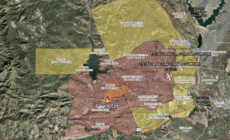-
Trump Wasn’t the First to Deport These Men, and He Won’t Be the Last - 3 mins ago
-
Insurer of last resort faces questions over smoke damage claims - 14 mins ago
-
Map Shows Where Canyon Fire Is Burning in Southern California - 31 mins ago
-
F.A.A. Plans to Hire 8,900 Air Traffic Controllers but Still Expects Shortages - 46 mins ago
-
Stanford Daily sues Trump administration citing threats to free speech - 55 mins ago
-
Woman Adopts Dog, Then Realizes She Doesn’t Know ‘Release Command’ for Food - about 1 hour ago
-
Democrats Are Finally, Slowly, Changing Their Minds on Israel - 2 hours ago
-
Man and woman found shot in car along Pacific Coast Highway were dead for several days, police say - 2 hours ago
-
How to Buy 2025 NFL Sideline Hats: Shop Official Trucker, Fitted, Adjustable, Flex, Split Panel Caps - 2 hours ago
-
Should Soccer Star Son Heung-min Have Held an Umbrella for a Female Reporter? - 2 hours ago
The start of California’s fire season has moved up 6 weeks since 1990 thanks to climate change
You are not imagining it. Fire season in California is indeed starting earlier and lasting longer in virtually every region of California than it did two decades ago, researchers have found, thanks largely to human-caused climate change.
In the Sierra Nevada, fire season starts about 24 days earlier than it did in the early 1990s. In the Northern Basin and Range region, which runs along the northernmost border with Nevada, it’s 31 days earlier.
And in the Cascade Range, which runs into Oregon, fire season now begins 46 days earlier than it once did, according to a study published this week in the journal Science Advances.
“Anecdotally, those of us living here have this sense that it’s been happening sooner,” said Amanda Fencl, a Berkeley-based water specialist who directs climate science for the climate and energy program at the Union of Concerned Scientists and was not directly involved with the research. “This is really an important study to quantify just how soon and where it is shifting, and to what extent.”
Newsletter
Toward a more sustainable California
Get Boiling Point, our newsletter exploring climate change, energy and the environment, and become part of the conversation — and the solution.
You may occasionally receive promotional content from the Los Angeles Times.
Although the number of people living in California has grown by roughly 27% since the early 1990s, human-ignited fires have dropped significantly during that time, enabling the researchers to rule out human-caused blazes as the source of the additional burn days.
Rather, the most significant factors shoving fire season forward are climate-related, they found: an earlier snowmelt and increased drying of soils and flammable vegetation as average temperatures rise.
“The main driver is the climate and meteorological conditions,” said Gavin D. Madakumbura, a UCLA postdoctoral researcher and the study’s lead author.
The effect is particularly pronounced in Northern California, where, in some regions, fire has become a near-constant threat.
“It’s often said we no longer [have] a wildfire season, but that wildfire season is all year, and that’s tied to warming temperatures,” said James Thorne, a UC Davis landscape ecologist who was not involved with the research.
Definitively linking longer fire seasons to anthropogenic climate change, as this paper does, is “a study I’ve been hoping someone would do for a long time,” he said.
California is already on pace to see more fires and significantly more burned acreage than it did last year.
More than 220,000 acres have burned in the state as of mid-July, almost 100,000 acres more than California has seen on average at this point in the year over the last five years, according to the California Department of Forestry and Fire Protection.
That total does not include the 96,000 acres burned in the Gifford fire, which was 15% contained as of Thursday, nor three different fires that started Monday in Southern California that together have burned more than 2,800 acres and are not yet contained.
It’s also the worst year on record for fire-related economic damages.
In 2018, the year the Camp fire destroyed the town of Paradise and killed more people than any wildfire in California history, wildfire damages statewide were an estimated $148.5 billion.
The Palisades and Eaton fires in January may have caused up to $164 billion in damages, a UCLA study found.
Times staff writer Grace Toohey contributed to this report.
Source link
















